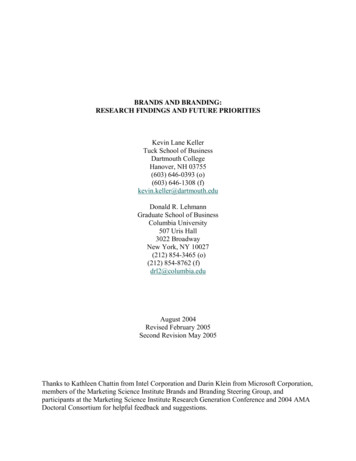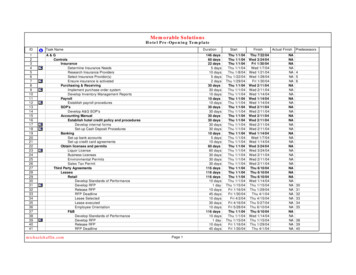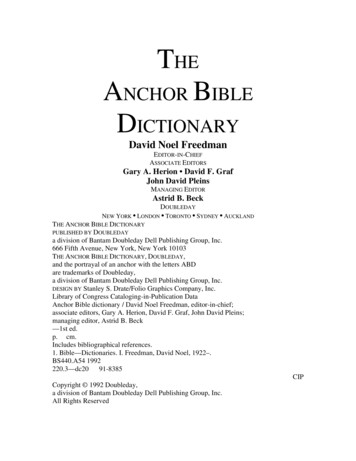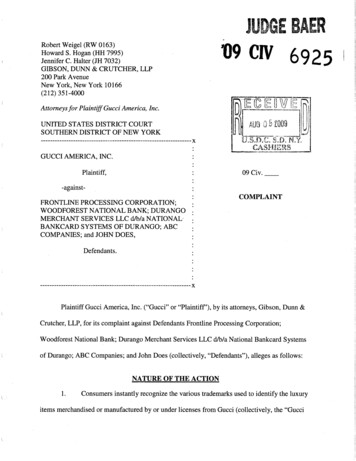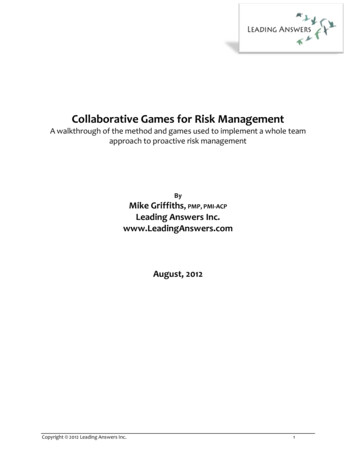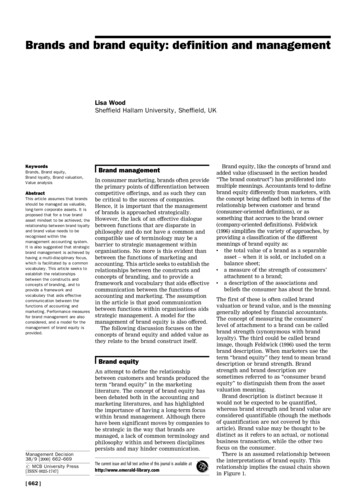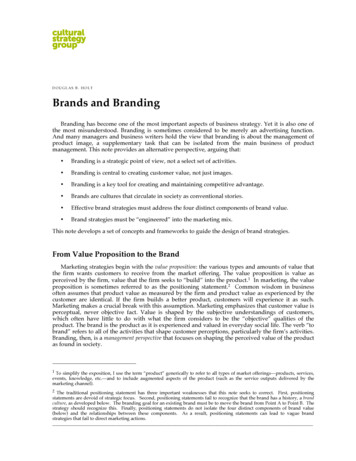
Transcription
DOUGLAS B. HOLTBrands and BrandingBranding has become one of the most important aspects of business strategy. Yet it is also one ofthe most misunderstood. Branding is sometimes considered to be merely an advertising function.And many managers and business writers hold the view that branding is about the management ofproduct image, a supplementary task that can be isolated from the main business of productmanagement. This note provides an alternative perspective, arguing that: Branding is a strategic point of view, not a select set of activities. Branding is central to creating customer value, not just images. Branding is a key tool for creating and maintaining competitive advantage. Brands are cultures that circulate in society as conventional stories. Effective brand strategies must address the four distinct components of brand value. Brand strategies must be “engineered” into the marketing mix.This note develops a set of concepts and frameworks to guide the design of brand strategies.From Value Proposition to the BrandMarketing strategies begin with the value proposition: the various types and amounts of value thatthe firm wants customers to receive from the market offering. The value proposition is value asperceived by the firm, value that the firm seeks to “build” into the product.1 In marketing, the valueproposition is sometimes referred to as the positioning statement.2 Common wisdom in businessoften assumes that product value as measured by the firm and product value as experienced by thecustomer are identical. If the firm builds a better product, customers will experience it as such.Marketing makes a crucial break with this assumption. Marketing emphasizes that customer value isperceptual, never objective fact. Value is shaped by the subjective understandings of customers,which often have little to do with what the firm considers to be the “objective” qualities of theproduct. The brand is the product as it is experienced and valued in everyday social life. The verb “tobrand” refers to all of the activities that shape customer perceptions, particularly the firm’s activities.Branding, then, is a management perspective that focuses on shaping the perceived value of the productas found in society.1 To simplify the exposition, I use the term “product” generically to refer to all types of market offerings—products, services,events, knowledge, etc.—and to include augmented aspects of the product (such as the service outputs delivered by themarketing channel).2 The traditional positioning statement has three important weaknesses that this note seeks to correct.First, positioningstatements are devoid of strategic focus. Second, positioning statements fail to recognize that the brand has a history, a brandculture, as developed below. The branding goal for an existing brand must be to move the brand from Point A to Point B. Thestrategy should recognize this. Finally, positioning statements do not isolate the four distinct components of brand value(below) and the relationships between these components. As a result, positioning statements can lead to vague brandstrategies that fail to direct marketing actions.
503-045Brands and BrandingBrand CulturesThink of the brand as the culture of the product. We can borrow from the disciplines ofanthropology, history, and sociology to understand products as cultural artifacts. Products acquiremeanings—connotations—as they circulate in society. Over time, these meanings becomeconventional, widely accepted as “truths” about the product. At this point, the product has acquireda culture.Consider a new product that has just been introduced by a new company. While the product has aname and a trademarked logo, and perhaps other unique design features—all aspects that weintuitively think of as “the brand”—in fact the brand does not yet exist. Names and logos and designsare the material markers of the brand. But, because the product does not yet have a history, thesemarkers are “empty.” They are devoid of meaning. Now think of famous brands. They have markersalso: a name (McDonald’s, IBM), a logo (the Nike “swoosh,” the Traveler’s umbrella), a distinctiveproduct design feature (Harley’s engine sound), or any other design element that is uniquelyassociated with the product. What is different is that these markers have been filled with customerexperiences, with advertisements, with films and sporting events that used the brand as a prop, withmagazines and newspaper articles that evaluate the brand, with conversations with friends andcolleagues that mention the brand. Over time, ideas about the product accumulate and “fill up” thebrand markers with meaning. A brand culture is formed. Let us consider how this happens.Four AuthorsBrand cultures accumulate as various “authors” create stories that involve the brand. Brands havefour primary types of authors: companies, popular culture, influencers, and customers.Companies The firm shapes the brand through all of its product-related activities that “touch”customers. All elements of the marketing mix—product, communication, channels, and pricingpolicies—can potentially “tell stories” about the product. We will take up the firm’s authoring role inconsiderable detail below.Popular culture Products are a prominent part of the world in which we live. As such, theyare frequently used as props in films, television, books, magazines, on the Internet, across all massmedia. These representations can have a powerful influence on brands. Popular culture can commenton brands directly—as when a talk show host like David Letterman spoofs an advertisement or whena product becomes a news story, such as when Firestone tires were recalled. Alternatively, brands canbe used as props in entertainment products such as films—as with Reese’s Pieces in E.T. and Pepsi inWayne’s World. For nearly a century, companies have sought to manage how their brands arepresented in the media, through public relations efforts and paid sponsorships.Customers Customers help to author the brand culture as they consume the product. As theyinteract with the product, customers create consumption stories involving the product, which theyoften share with friends.Influencers In many categories, noncustomers’ opinions are influential. Think of trademagazine reviews, the opinions offered by mavens and connoisseurs during work and leisuregatherings, and the opinions offered by retail salespeople.Of course, the stories circulated by these four authors interact, often in complex ways. Customerswatch ads and listen to influencers as they use the product. The media monitor how customers usethe product and consider this in how they represent the product. In fact, the quantity and complexityof these interactions mean that isolating the influence of each author is usually quite difficult.2
Brands and BrandingSource:503-045Casewriter.Stories, Images, and AssociationsThe cultural materials circulated by these authors come in three forms: stories, images, andassociations. Stories and images are the more potent sources of brand culture. Brand stories andimages have plots and characters, and they rely heavily upon metaphor to communicate and spurour imaginations. Think of brand associations as the residue of these stories and images. We mayforget the specifics of a product story but still attribute some characteristics to the brand (“it’s for oldpeople,” “often falls apart,” etc.).As these stories, images, and associations collide in everyday social life, conventions eventuallyform. A common story emerges as a consensus view (or, often enough, a few different commonstories, each of which constitutes a customer segment for the brand). At this point the brand hasbecome established as a cultural artifact. Marketers often think of branding at the individual level asperceptions of individual consumers. But what makes branding so powerful is the collective nature ofthese perceptions, the fact that the stories/images/associations have become conventional and so arecontinually reinforced because they are treated as “facts” in everyday interactions.3A Perceptual Frame Structuring Product ExperiencesIt is common in marketing to think of the brand as an image, as the “frosting on the cake” aboveand beyond the “actual” value delivered by the product. This intuition distorts how brands createvalue. Rather, a brand culture acts as a perceptual frame through which customers understand, value,and experience the product. Customers never experience products objectively. Rather, the brandculture acts as a frame, shaping how their senses (see, hear, touch, feel, smell) experience the product.Brand cultures can have a powerful influence on sensory appeal (e.g., how products taste), on theemotions one feels when consuming, and on the remembered satisfactions of the experience.3 Of course, individuals’ experiences with brands are more complicated. People routinely overlay brand cultures with theirown personalized stories, images, and associations. These many “stray” stories that individuals weave into their consumptioncan add to and alter the conventions of the brand culture. However, as marketers are usually interested in aggregations ofcustomers, these idiosyncratic meanings have little managerial relevance unless they aggregate to transform conventions.3
503-045Brands and BrandingBrands and Competitive AdvantageBranding is a potent means to establish competitive advantage. The brand culture concept helpsus see why this is so. Brand cultures are “sticky.” Once they have accepted them as conventionalwisdom, people are usually reluctant to abandon the conventions of the brand culture. Unless theyhave product experiences or encounter brand stories that profoundly contradict conventions, peopleare usually happy to maintain the taken-for-granted understandings of the brand. In addition to thestickiness of taken-for-granted understandings, there are two reasons for this durability.Psychological research demonstrates that brand cultures are durable because people are cognitivemisers. Because we are so overloaded with information—far more information than we canreasonably digest even if we wanted to—we rely upon a variety of heuristics to simplify the world.We seek ways to minimize the amount of thinking and searching that we must do to make gooddecisions. Brand cultures work as one such heuristic. Once we determine that the conventionalwisdom of a brand culture “works” for us (e.g., a detergent whose conventional brand story is that itperforms great in all temperatures seems to do so), we are not interested in seeking out newinformation that would contradict this assumption. The heuristic provided by the brand works well,so we go on using it.Sociological research demonstrates another reason why brand cultures are durable. Brand culturesare shared by many people and expressed in a variety of contexts (talk, product experiences, ads, andso on). Brand cultures are maintained as the brand’s stories, images, and associations pulse throughthese networks. Hence, it is quite difficult for an individual to opt out of the conventional wisdom ofa brand culture and assign the brand alternative meanings. Just as brand cultures are formedcollectively, to decommission a brand is also a collective decision. Because of this network effect,brand meanings maintain a tenacious hold until a critical mass of customers and influencers jointogether to transform conventions.Powerful brand cultures provide competitive advantage not only with respect to consumers butalso in negotiations with channel partners. A strong brand culture gives the firm considerableleverage in configuring channel policies and provides leverage in negotiating with retailers.The Four Components of Brand ValueBrand cultures can greatly enhance customer value. If we conduct a thought experiment, we canimagine the value of a brand as the difference between what a consumer will pay for a brandedproduct (a product experienced through the lens of its brand culture) and a physically identicalproduct without the culture. This difference can be decomposed into four dimensions, which,together, constitute the value added by the brand. The four components each have a strong base ofresearch in academic disciplines that inform marketing. Each of these four components accumulatesthrough the stories, images, and associations of the brand culture.Reputation Value: Brand Cultures Shape Perceived Product QualityFrom an economic point of view, brands serve as containers of reputation. Products have tangiblefeatures that deliver on utilitarian goals: flights are on time, fabrics clean easily, tools never breakdown. Customers take on risk when they purchase products, particularly products that will be usedinto the future and products for which quality cannot be reliably evaluated upon inspection beforepurchase. Sometimes the risk is huge: for consumers, consider the purchase of an automobile or anHMO policy; for business to business (B2B), consider the purchase of a mission-critical softwareprogram. Customers, to varying degrees, get added value from products that lower the risks of futureperformance failures. So when there is risk inherent in a product, customers are usually willing topay to reduce risk. The brand operates as a signaling mechanism to increase customers’ confidencethat the product will provide excellent quality and reliability on important functions. The history of4
Brands and Branding503-045product experiences—both successes and failures—is spread in stories and aggregates to form part ofthe brand culture.Relationship Value: Brand Cultures Shape Relationship PerceptionsBrands also communicate that the firm producing the product can be trusted to act as a long-termpartner that will flexibly respond to future customer needs. For many products, especially in B2B andin services, customer uses and needs cannot be fully anticipated (and so built into a contract) at thetime of purchase. For these
Brands and Branding Branding has become one of the most important aspects of business strategy. Yet it is also one of the most misunderstood. Branding is sometimes considered to be merely an advertising function. And many managers and business writers hold the view that branding is about the management of product image, a supplementary task that can be isolated from the main business of .

